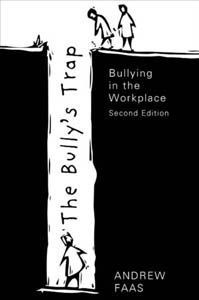The Bully in the Workplace

Review of The Bully’s Trap: Bullying in the Workplace
Andrew Faas, The Bully’s Trap: Bullying in the Workplace, (Mustang OK:Tate Publishing, 2015)
Faas writes, “Why do bullies bully?” The simple answer is because they work in an environment where it is allowed, condoned, encouraged, and even expected....but where bullying is not allowed or condoned it will stop.
Andrew Faas was a senior executive in retail for three decades, and during that time demonstrated how to lead and manage a business, not from fear and bullying, but through establishing cultural dynamics that are based on values, motivation, and positive leadership to create a strong organization and a safe place to work. His ideas are relevant to bullying in multifamily residential situations.
He presents numerous examples and cases to show the physical, psychological, and career harm that bullying does to targets in the workplace, but also demonstrates the way that bullying actually weakens the firm, increases employee turnover, reduces productivity, and hurts the reputation and valuation of the company. He asserts that when fear is used as a substitute for motivation and positive leadership, the firm and everyone in it suffers.
The bully's trap consists of the bully blaming the victim; the victim is harmed by the bullying and the symptoms are used to excuse the bullying. It can be difficult to distinguish victim from bully, but it can be done. In the residential setting, the perpetrators of bullying constantly pressure, isolate, and provoke their victims. And when the victim lashes out, the perpetrators accuse the victim of rule violations and bullying. The victim is trapped.
Faas had been called out as a bully in his early management position, but then adopted effective leadership skills and went on to a successful career. He was severely impacted when, as a whistle-blower, he was victimized in retaliation. And he demonstrated that bullying is not an effective way to lead, but that appropriate management techniques do provide a safe and productive work environment.
Faas make clear that trying to change "the bully" is unlikely to change the workplace. Instead, everyone from the chief executive to the employee must be on board with the belief that bullying is harmful to the goals of the organization: bullying is "...a risk to the individual and to the organization.
Although the corporate world of retail sales is certainly a far cry from subsidized housing, nevertheless the dynamics of corporations that Faas describes do not seem so different from the dynamics found in organizations that own and manage housing.
Can we apply the Faas theory of bullying in the corporate world to bullying in multifamily residences? If so, then we must change the culture of the landlord and the management company, and the culture of social service agencies if we are to succeed with eliminating bullying in the residential setting.
I have observed that housing where bullying flourishes deserves and receives a bad reputation, making it difficult to recruit and retain motivated, skilled employees, and even in an environment of scarce affordable housing, a bad reputation can lead to multiple vacancies, a significant cost to the landlord. Employees can be just as unhappy as the residents. Just as Faas discovered in the commercial world, we see also in housing that bullying is one indicator of ineffective management.
Faas shows that bullying of workers in the corporate setting can have serious impacts on the victims and their families, causing long-term unemployment, severe emotional and physical disease, stress, depression, and even suicide.
In multifamily housing, bullying of residents deprives them of the peaceful enjoyment, their wellbeing and health, and even restricts their human and civil rights.
I propose that, just as employees in the corporate setting need to be respected and treated as partners in the success of the enterprise, residents of multifamily housing need to be engaged in dialog with management to make them partners in the success of the housing program. Such engagement seems to help eliminate bullying and create a healthier community for managers and staff as well as for residents.
Subsidized housing was intended to be a service industry, but many housing providers today, even nonprofits, work mainly to enlarge their portfolios of subsidized housing and to assure returns to their investors. Housing providers are not held to account for the quality of life of their customers, but only watched for their bottom lines and their maintenance of property. I suspect that if we find bullying in the residential setting, we are likely to find it in the management office and in the offices of the landlord.
Faas defines categories of management and institutional organization, with the ideal being the "stable" culture. Values and beliefs are at the core of stable cultures. There is the recognition that people are the key component to the success of the organization. When he is brought in to help an organization, he shows the leaders how to assess the culture and promotes a whole culture of effective leadership.
Maureen Duffy and Len Sperry also show the need to use organizational development to improve an organization while eliminating mobbing, an extreme form of bullying. (1)
Since 2005 Faas has run a nonprofit organization, the Faas Foundation, which works to educate and inform about bullying and to support organizations involved in research and in creating psychologically safe workplaces.
This is a book that will repay careful study and can be used as a guide in recognizing bullying and starting a change of corporate culture. It reinforces my belief that to address bullying in housing, we should not begin with the bully, the group of bullies, the social worker or resident service coordinator, or the residents. Instead we should begin at the top of the organization of the housing provider, and only when we have a management culture that will not condone bullying, can we effectively deal with bullying. In housing, where the manager and service coordinator have the support of their superiors and their organizations, bullying can be nipped in the bud, often with a brief conversation, making it look like the easiest problem to resolve.
We owe a debt of thanks to Andy Faas, whose experience, dedication, and zeal for reform are making a difference.
Andrew Faas, The Bully’s Trap: Bullying in the Workplace, (Mustang OK:Tate Publishing, 2015)
Available on Amazon.com and by a free epub download: http://www.andrewfaas.com/
Andy Faas, talking about bullying in workplace: http://www.faasfoundation.org/speeches1/tedx-chatham-kent
(1) Duffy, Maureen and Len Sperry, Overcoming Mobbing: A Recovery Guide for Workplace Aggression and Bullying, (New York: Oxford University Press, 2013).
- Log in to post comments
